How To Draw Eyes–A Detailed Guide

Drawing Eyes Can Feel Difficult, But It Doesn’t Have To Be.
I’ve resisted writing this kind of post for a long time. In my experience, the type of instructional content found in countless books, blogs and YouTube videos with titles like How To Draw Eyes (or anything else) is usually oversimplified and misleading.
There are 2 reasons for this. First, when you draw a portrait, things like the model’s individual morphology, our perspective as the viewer, and the lighting environment are different in every case, and can profoundly impact your decisions. Drawing well is usually more complicated than just following a list of formulaic steps that don’t take variables into account.
Second, thinking in terms of “how to draw eyes” – as if the eyes are somehow privileged and separate from the rest of the face, head and body – breaks up the figure into artificial categories. In truth, there’s as much structure to be observed on the model’s cheek or forehead as in the eyes, but we tend to be unaware of that (there aren’t many “How to Draw Foreheads” tutorials out there). Instead, we focus on “eyes”, “nose” and “mouth” too much, and forget about everything else. Articles like this make me queasy because they seem to reinforce this way of thinking.
Nevertheless, learning to draw eyes is something a lot of students struggle with, often unnecessarily. We tend to approach the eyes in our drawings with lots of anxiety because they’re psychologically important to human beings. It’s also where we look first in a portrait. Mess up the eyes, and you’re suddenly stuck with a “bad drawing”, while the same degree of error in describing the neck or chin may go unnoticed by most viewers. It’s not fair, but it’s the way it is.
In this post, I’ll lay out the things I think about most when drawing eyes on a portrait. Whether you’re working on a simple eye sketch, a detailed eye drawing, or drawing eyes for beginners, these principles will help you develop better eyes. I’ll try to take some variables into account, but remember these instructions are not universal. There will be plenty of times while drawing a model when you’ll encounter problems not mentioned here. But that’s what learning to draw portraits is like. As similar as human beings are to one another, there’s still no one-size-fits-all instruction set for drawing eyes – or anything else. The way forward is to absorb what you can from teachers you trust, but be prepared to adapt and improvise as you encounter unique problems… because you will.
So, let’s get started.
Big Things First
This is good advice for drawing any subject, not just eyes, because it’s easy to get bogged down in details when drawing something complicated. Whether you’re doing an eye drawing practice session, following an eye drawing tutorial, or working on a sustained effort drawing realistic eyes, it’s important to start with the fundamentals. Eyelashes, wrinkles and subtle highlights are all fun to draw, but are nothing but distractions early on (ones I still succumb to from time to time). As students who’ve taken online courses at Vitruvian Studio already know, it’s always advisable to work from “general” to “specific” while drawing. In other words, establish the biggest, broadest shapes first, then subdivide them to arrive at the smaller, more specific characteristics.
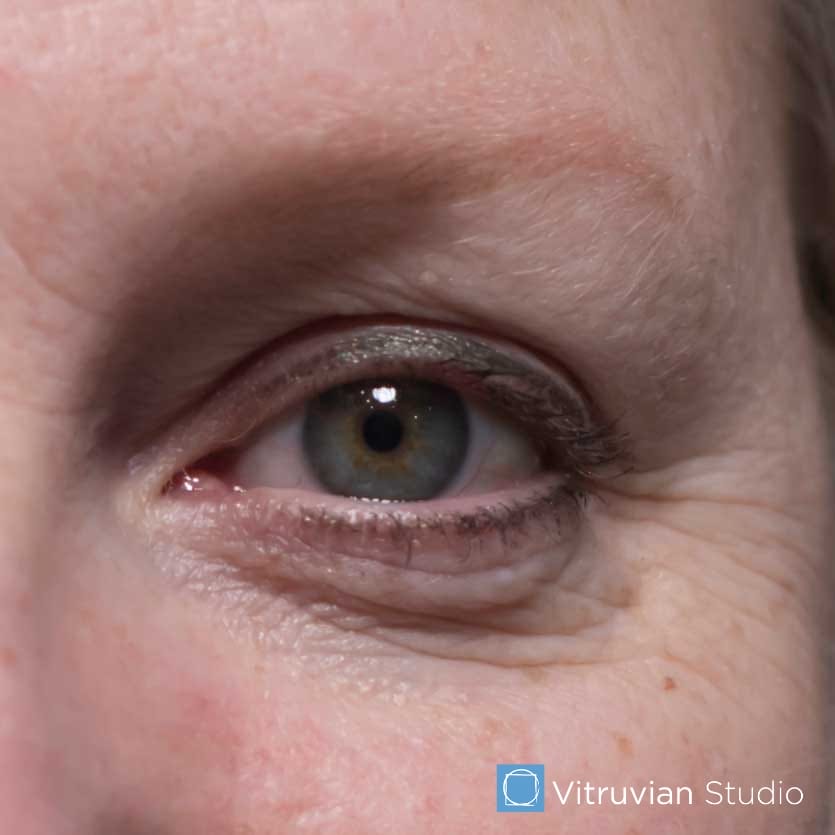
Context is Important
You don’t have to be a comedian to know that when telling a joke, you can’t just jump to the punchline. You have to “set it up” first. If you don’t, even the funniest joke in the world won’t quite work.
The same principle applies to drawing.
The biggest problem with most “how to draw eyes” tutorials is that they jump too quickly to drawing… well… eyes – the eyelids, iris, pupil, etc – without first setting-up a structural context for the eye. In other words, eyes look the way they do in part because of everything that surrounds them.
This means that we need to look beyond the boundaries of the eye itself to consider the broader eye region, including the bony structures of the forehead and brow, the cheekbones, and the nose. Understanding eye anatomy and the structure of the eye is essential for creating convincing eyes.
1: Build the Eye Socket
The eyeball is set deep within a cavity in the skull called the “orbit” – or more commonly, the “eye socket”. Understanding eye socket anatomy is fundamental to drawing realistic human eyes. Each eye socket on the skull is bordered visually by 3 bones:
- The Frontal Bone across the top, forming what’s called the “brow ridge”
- The Maxilla along the inside (medial) edge and the lower medial corner
- The Zygomatic Bones, or cheek bones, along the outside (lateral) edge and lower lateral corner
(In the front view, the nasal bones may appear to border the eye socket, but they’re actually set quite far forward of the orbital cavity, so I haven’t listed them here.)
These three bones are what give the eye socket its characteristic shape, which in the front view isn’t really round, but more of a rhombus with rounded corners. This rhombus-shaped structure is key to drawing eyes in perspective and understanding eye proportions.
Starting with an HB pencil, lightly mark the boundaries of the eye socket on the page. If you’re doing drawing eyes practice or working from an eye reference, looking for certain landmarks will help you do this:
- The eyebrow: While it doesn’t mark the top of the socket (that sits lower), the eyebrow is useful because it’s often easy to see and it marks a plane change where the brow ridge begins to turn down and in toward the eye socket.
- The supraorbital margin: this is the actual top border of the socket itself, and is often marked by a deep crease at the top of the upper lid, where it folds on itself as it rolls up and under the brow ridge, like a retractable awning. This sharp definition is sometimes seen down the lateral side as well, along the upper part of the zygomatic bone. (Due to the eye cover fold, this crease isn’t visible on individuals of asian descent.)
- The inner canthus, or “tear duct” at the inside corner of the eye, marks the medial (or inside) edge of the eye socket.
- The infraorbital furrow marks the bottom boundary of the socket, and is often seen on the surface as a soft ridge running downward and laterally from the inside corner of the eye. Its trajectory echoes that of the brow ridge above it.
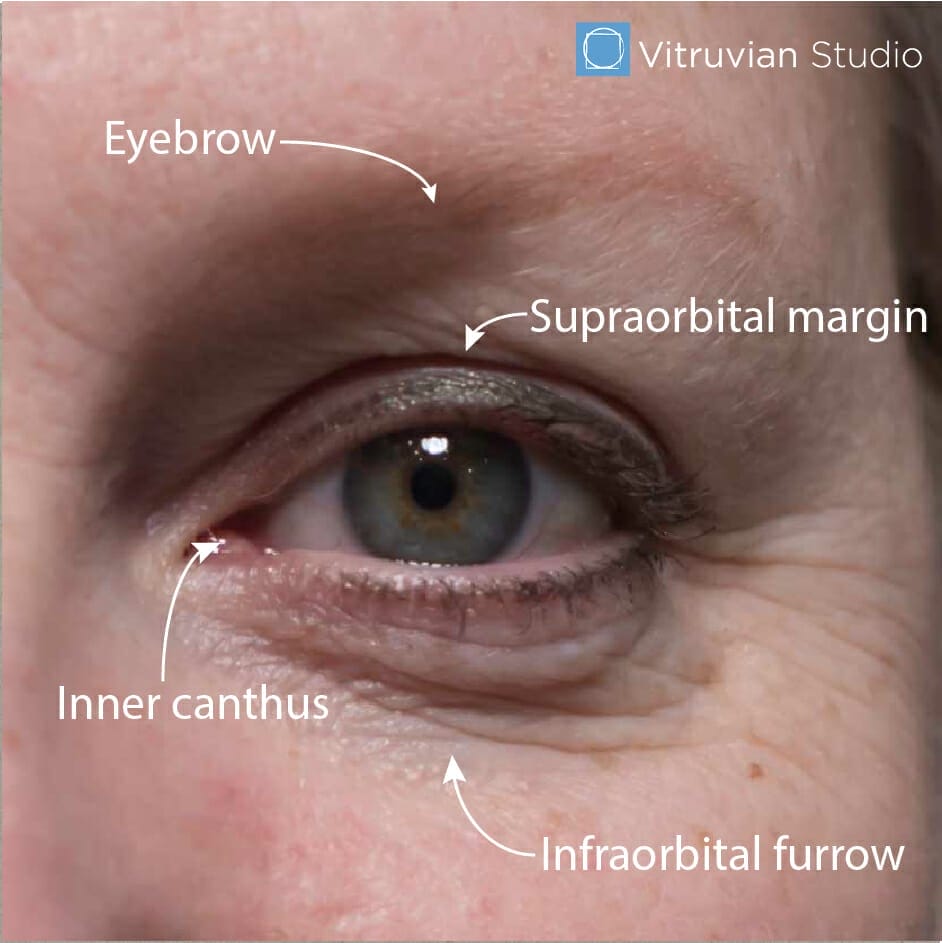

Keep it light! These lines are merely placeholders that you’ll likely want to remove later. Don’t blast them in! When sketching eyes, draw lightly with the shoulder of the pencil lead to avoid gouging your paper.

Want to know more about how we draw at Vitruvian Studio?
Subscribe to our list and get a FREE Drawing Materials Guide – a catalog of the materials we use in the studio.
2: Block-in the Shape and Position of the Eyelids
Learning how to draw eyelids is one of the most important steps to draw eyes successfully. When blocking-in the eyelids, remember that they’re stretched around the eyeball beneath them, which largely determines their shape. The trajectories of the lids as they arc across the eyeball are essentially cross-contours on a sphere – like lines of latitude on a globe. On the eye, these trajectories aren’t perfectly elliptical because they get pushed around by the cornea on the eyeball and the bony structures of the socket. Nevertheless, the eyeball is basically round, and that roundness is the biggest influence on the shape and path of the eyelids as they arc from corner to corner.
The nice thing about building the eye socket first is that it helps us find the outer boundaries of the lids:
- The top of the upper lid is defined by the top of the eye socket – the “supraorbital margin” – and follows its downward-lateral trajectory.
- The bottom of the lower lid sits just above the infraorbital furrow at the bottom of the eye socket, and also echoes its downward-lateral trajectory.
- The inside corner of the eye sits directly on the inside edge of the eye socket. We only need to determine how high or low it sits.
- The lateral corner of the eye is coincident with the supraorbital margin laterally as it turns down toward the zygomatic bone.
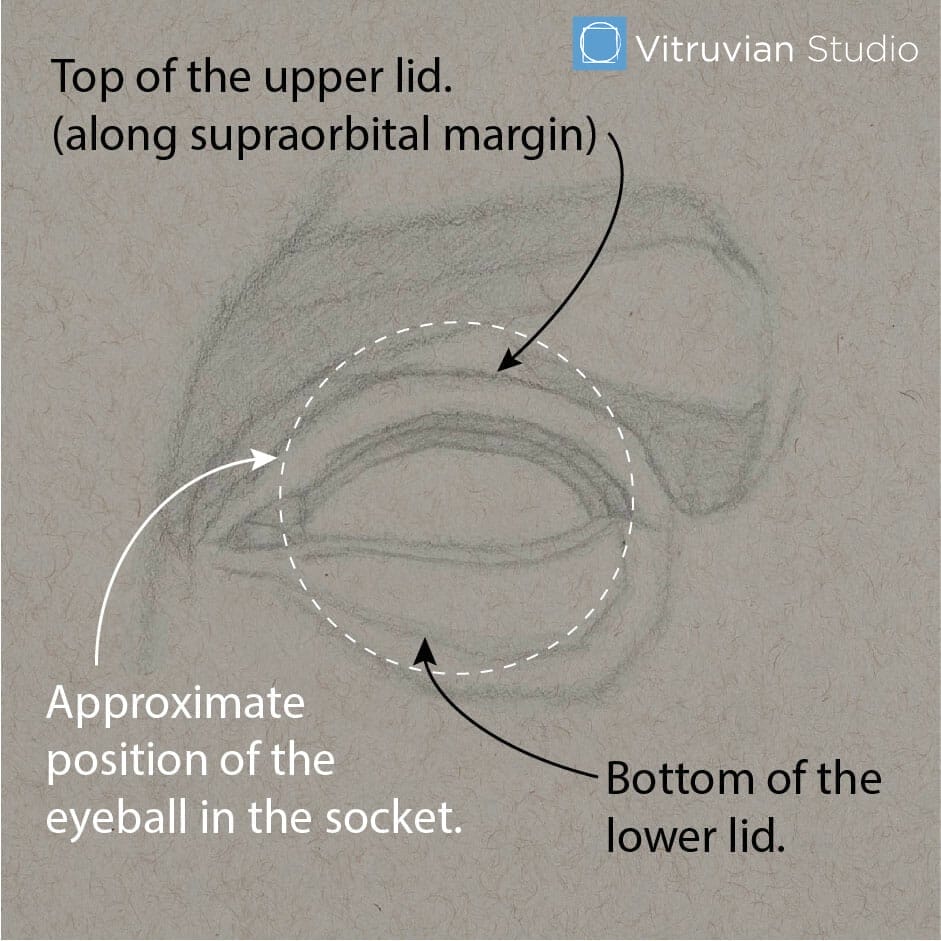
At this point it may be noticeable that the eyeball sits surprisingly high within the eye socket, being tucked up and under the top of the supraorbital margin.
Note:
If you’re wondering how to draw an eyeball at this stage, some tutorials advocate this, and it makes a certain amount of sense. After all, the eyeball fills much of the eye socket we just finished establishing, and is responsible for much of what we perceive as the shape of the eye, so its influence is important.
I don’t suggest we draw the eyeball directly, however, because we see so little of it. Being mostly covered by the brow ridge and eyelids, the precise size and position of the eyeball in the socket can be ambiguous at best. The tendency is to draw the eyeball either too big or too small, and too low in the socket, which can create problems for us down the road.
Instead, let’s proceed by blocking in the parts of the eye we can actually see (either directly or through their influence), starting with the larger, containing shapes. At this stage, with the eye socket already established, that means drawing the eyelids.
The Orientation of the Eye
It’s easy to assume that the eye, from corner to corner, sits horizontally on the head, but that’s often not the case. Usually, one of the two corners of the eye sits slightly higher than the other.
This can vary between individuals and with your angle of view on the model, but it’s always worth checking. Imagine a straight line connecting the two corners of the eye and determine its tilt. Then try to replicate that angle on the page as carefully as you can.
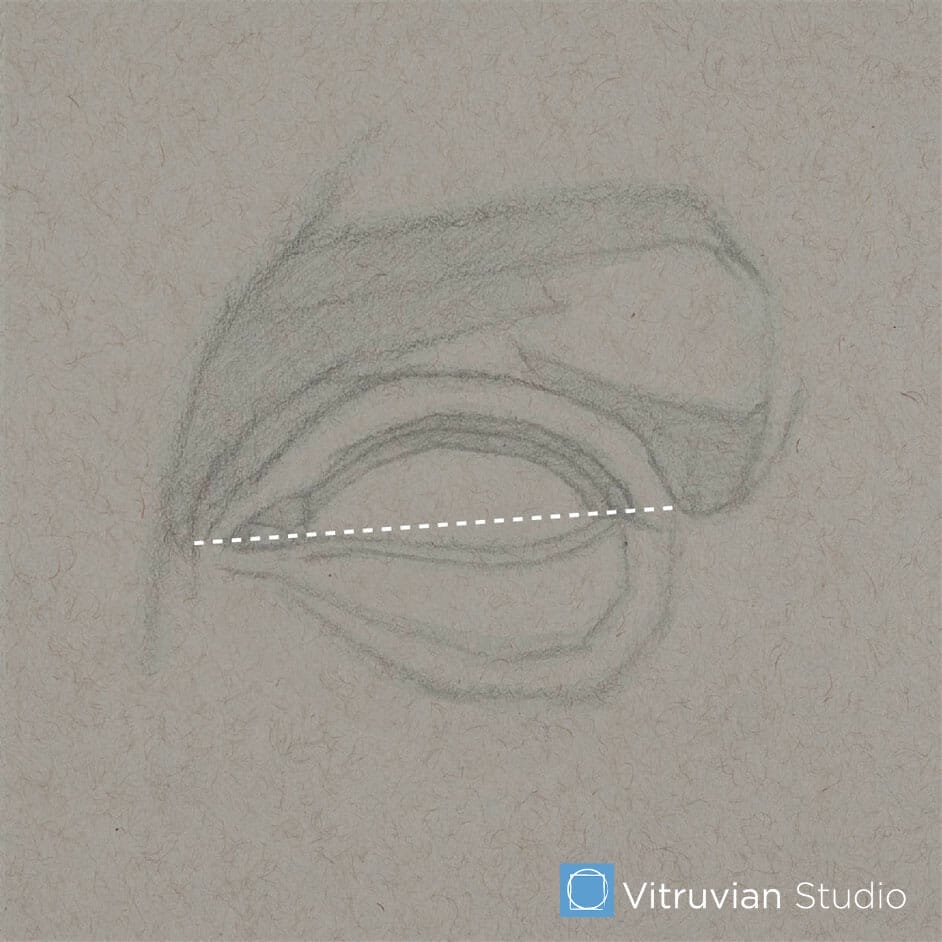
About the Shape of Eyelids
The eyes are not shaped like footballs or almonds. And yet, this is one of the most common mistakes made by students – and for that matter, many “how to draw eyes” tutorials.
While it’s true that the opening between the lids tapers to a point on each side, that shape is also asymmetrical.

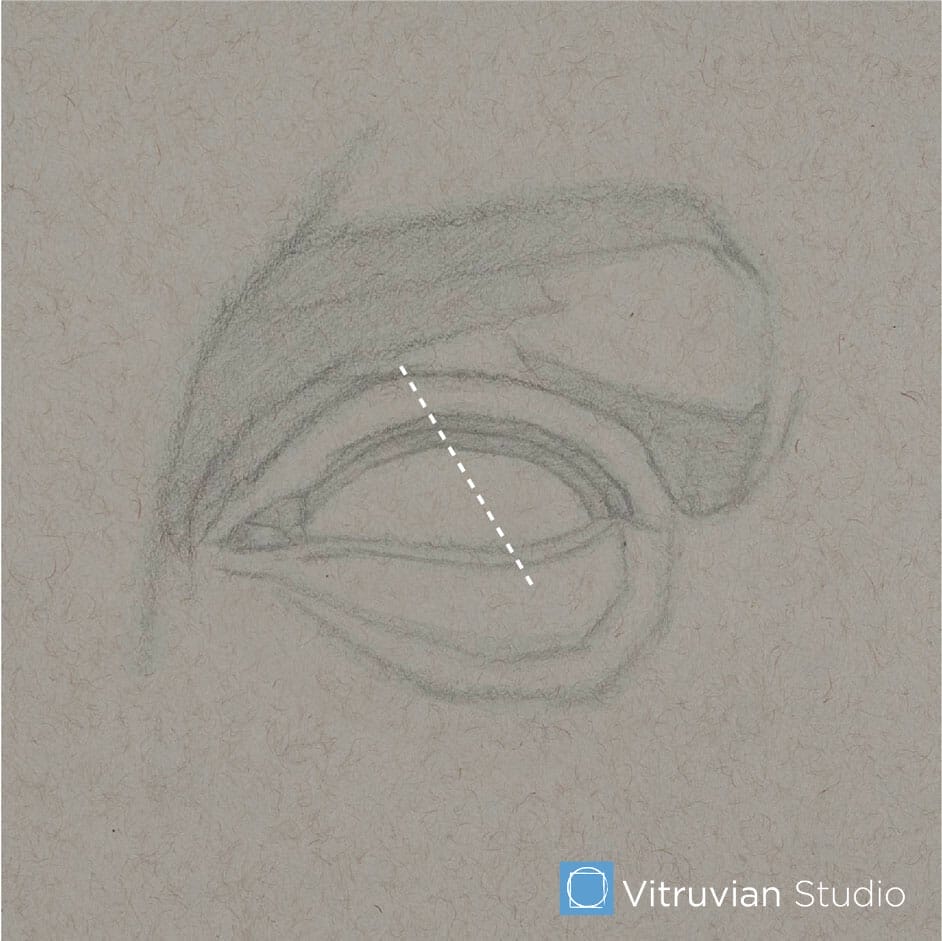
The Outer Boundaries:
Look for the “high point” – or apex – of the curve of the upper lid and you’ll find it sits somewhat medially (or toward the inside). This is because the form of the lid follows the path of the supraorbital margin, which is angled downward, laterally.
The Inner Boundaries:
The outer and inner boundary of each eyelid echo one another, but they aren’t parallel. The inner boundaries appear less curved when the eyes are open because of perspective – they aren’t rolled up or down over the eyeball as much as the outer boundaries, which makes the curvature appear less amplified from our angle of view.
Understanding eye shape and eye shapes for drawing is crucial for drawing different eyes. It’s also important to note that in conventional portraiture, with a more-or-less eye-level view on the model, the upper lid often appears more rounded and the lower lid “flatter” (this isn’t always the case, but it happens frequently enough to be worth mentioning). The reason for this is simple. When the eye opens, the upper lid does most of the work, rolling up and over the eyeball, like an awning. The lower lid stays relatively stationary. This means that the upper lid sits up on top of the eye when it is open, arcing up-and-over the round form of the eyeball, and thus appearing more rounded from our point of view. The lower lid, by comparison, doesn’t “roll down” very much, but rather pulls relatively straight across, appearing less curved from our point of view.
The Eyelids Have Thickness
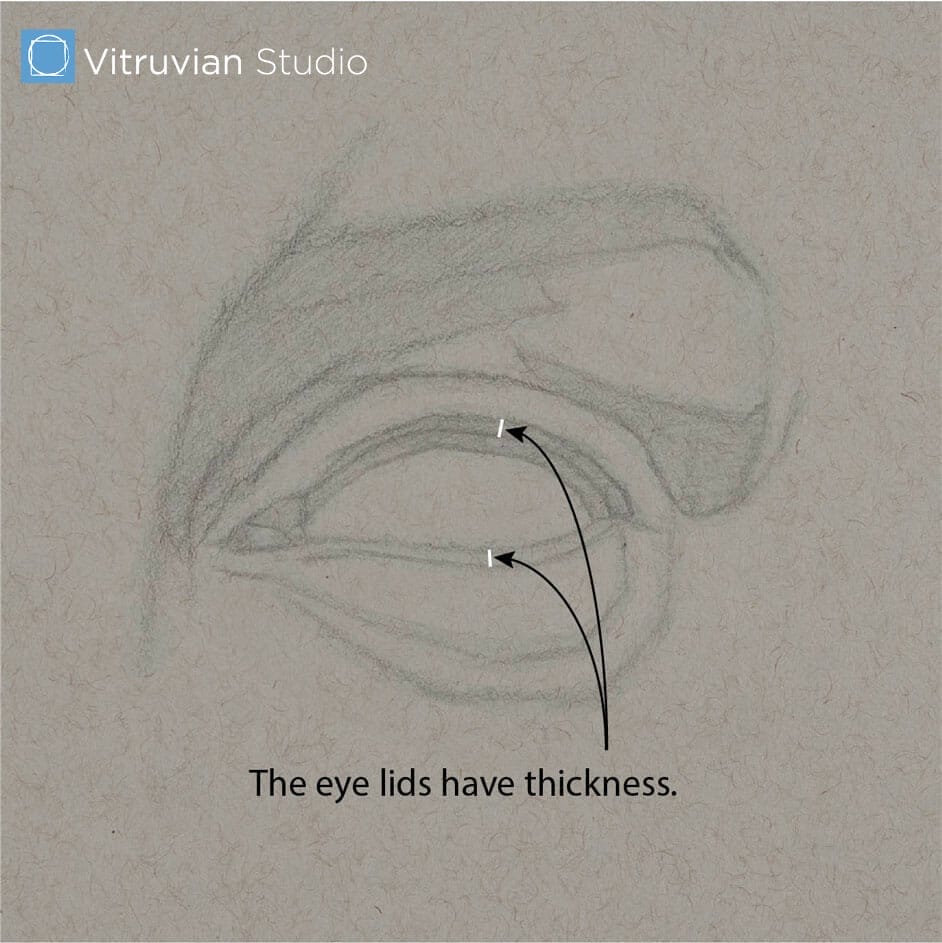
Even in a line drawing, a single line is often inadequate for describing the structure of each eyelid. This is because the eyelids have thickness and we can often see the top or bottom surface of the lids projecting outward from the surface of the eyeball. When drawing eyelids, including these planes in your drawing will help give your eyes dimension, making the eyeballs appear relatively recessed into the eye sockets – which they are.
3: Adding the Iris and Pupil
Learning how to draw pupils and the iris correctly is essential for creating good eyes. With respect to drawing the eyeball, there are four components we need to consider:
- The pupil is basically just a hole in the eyeball allowing for the ingress of light.
- The iris is a pigmented disc that surrounds the pupil, featuring a complicated mechanism that allows the aperture to expand or contract.
- The cornea is a raised, transparent dome-like structure that sits on top of the pupil and iris.
- The sclera comprises the remaining surface of the eyeball and is what we commonly refer to as the “white of the eye”

Scale
Students often struggle with finding the appropriate scale for the iris and pupil. The tendency is to draw them too large, filling up too much of the space between the eyelids, which can make a portrait look infantile or like an anime character.
A popular rule of thumb is that the size of the iris is about ⅓ that of the whole eyeball. This is roughly true, but it’s also tricky to apply. We don’t see the full width of the eyeball because much of it is covered by the bones and eyelids, so determining ⅓ of that distance usually involves some guess work. So keep the thirds rule in mind, but also try to observe the proportion of iris to sclera visible on the eye from your point of view. If the iris is too big on your drawing, the space available for the sclera will be too small.
Shape
When viewing the eye from the front, the iris and pupil appear circular… or at least close. You may occasionally observe on some individuals that these shapes aren’t perfectly round, but it’s wise to draw them as circles anyway. Otherwise, it may look like a weird drawing error.
If the model’s gaze is turned away from you, however, the circles of the iris and pupil will become elliptical. For a comprehensive procedure for drawing ellipses correctly, check out our Drawing Basics course!
The Iris is a Light Bucket
An important feature of the iris that’s often overlooked is that it has depth. The outer rim of the iris sits flush with the surface of the sclera, but the inner aperture of the pupil is set somewhat inward. This gives the iris a noticeable “bucket” or “lampshade” structure (or “like the laser canon on the Death Star” as one student aptly put it.) This inverted shape has important consequences for our light and shade development, as we’ll see later.
The Cornea
Covering the iris and pupil is a transparent dome called the cornea, which assists in focusing light into the eye. Think of the cornea as being like a contact lens sitting on the front of the eyeball. It isn’t directly visible because it’s see-through, but it’s influence is: eye highlights seen on the eyeball often sit on the cornea, partially obscuring the iris and pupil, because the cornea projects forward.
This forward projection of the cornea also has an influence on the shape of the upper eyelid. Depending on the direction of the model’s gaze, the lid may get pushed upward and outward over the “bump” of the dome-shaped cornea. This can influence where we perceive the high point of the upper lid to be as it arcs over the eyeball.
And Now The Fun Part: Light & Shade
With the linear structure established, it’s time to transition toward light and shade development. This is where we build upon the work we’ve done to make the eye appear convincingly illuminated and 3-dimensional. Whether you’re working with an eye reference drawing, a photo reference, or drawing from life, this stage is crucial for creating realistic eyes.
You may have already completed (or partially completed) he first step toward this goal: drawing the shapes of the shadows. This helps us in the linear stage in getting positions and proportions right, but it’s also how we begin to indicate the different orientations of planes on the eye. If we do this right, we can create a rudimentary sense of form with just 2 values: one for the light side and one for the shadow. This binary statement is called a “poster”.
Think of the light masses and shadow masses as being like puzzle pieces – they should fit together perfectly. The border between these puzzle pieces is what we call the “shadow edge” or “terminator”. The terminator is what we’re going to draw at this stage with a soft line as it bumps over the various forms of the eye region.
As you carve out the shapes of various shadows on and around the eye, hatch them down lightly with an HB pencil. For those wondering how to draw better eyes, this will help you see if your shadow shapes are correct.
A Note about Lighting:
A Note about Lighting: This is the stage where poor reference material can really cause you problems. When selecting eye reference photos or an eye drawing reference, lighting is critical. A lot of studio photography uses multiple light sources with large diffusers to fill shadows and make blemishes and wrinkles harder to see. The effect can be flattering, but it’s also flattening. Without any shadows, there’s little to tell your brain what planes are oriented in what direction, so creating the illusion of 3-dimensional form in your drawing is nearly impossible without lots of invention.
To solve this problem, draw from life when possible. If drawing from life isn’t an option, always ask yourself this question when choosing a photo reference: “Where is the primary light source in this picture?”. If you can’t tell, keep looking for a better photo, or take one yourself!
4: Reference Values
Before beginning the full light and shade development on the eye (or on anything), we first need to set the range of values. This is important because “light” and “dark” are relative. We can only determine how light or dark something should be in comparison to the lightest light and darkest dark. We call these “reference values”. I liken the role of these values to that of the oboe when tuning an orchestra – all the music that is to follow is tuned relative to that.
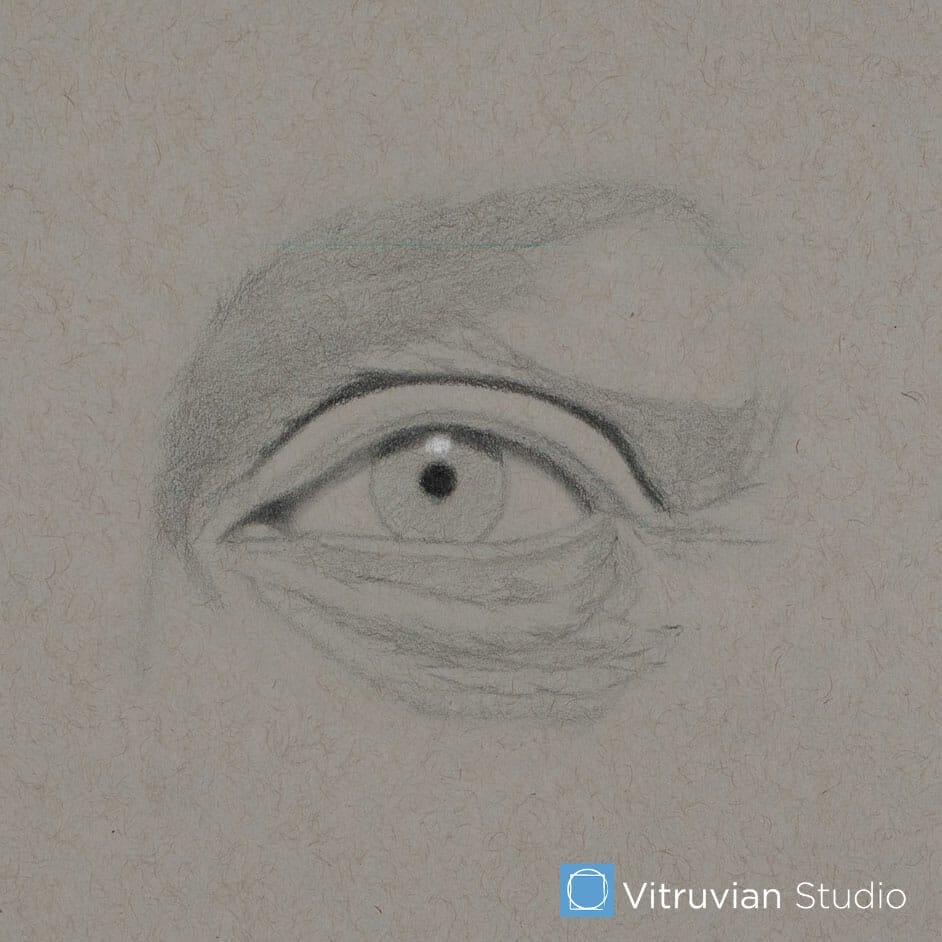
The darkest darks in the eye region are predictably found in a few places (assuming the light is traveling from above). The deep crease of the upper lid along the supraorbital margin is one candidate. The pupil of the eye is another (assuming it’s not obscured by any reflections on the cornea).
The lightest lights are usually observed on the up-turned surfaces of either lid, or perhaps in a highlight on the cornea or sclera. Highlights are reflections of the light source, after all, and so they tend to be quite bright.
5: Tuning “Chords”
With the reference values in place, it’s time to begin “tuning” the values of nearby areas, carefully gauging the “interval” between different notes. This can be tricky to do well – at least if you’re new to this idea – but here are a few tips for drawing eyes effectively:

- Work adjacent areas. Don’t hop all around your drawing at this stage. It’s easier to judge value relationships when they’re right next to each other.
- Tune small intervals first. It’s easier to judge small intervals than larger ones. With the darkest dark established, look for the next darkest nearby value and develop that first.
- Work across boundaries. Don’t let the names of things confine you. If you’re working in the iris/pupil area, be sure to develop nearby values on the sclera and the lids, too. Don’t try to complete anything before you’ve integrated it with the surrounding value structure.
6: Modeling Forms
At this stage, your drawing may resemble a patchwork quilt, with a few clusters of different values tuned to each other. It’s now time to begin organizing these flat notes of value into progressions – or gradients – that get darker or lighter as the form turns away from or toward the primary light source.
Remember that the eyeball is a sphere. The lids follow the curvature of that sphere as they arc across the eye from one corner to the other, meaning the orientation of these surfaces relative to the light source is constantly changing. In order for our drawing to appear 3-dimensional, it’s necessary to describe the “turning” of these surfaces with gradual changes in value running in different directions.
To some extent, this can be done visually – just compare your drawing with your reference and try to match the value relationships you see. But it’s also necessary to consider the direction of the light. By this I mean thinking in a 3-dimensional way, considering the relative orientation of different planes to the light source. Assuming a consistent local value and distance to the light source, surfaces that face the light more directly should be lighter than those the face the light less directly. Being aware of this can help convey value changes that you may not notice visually – the difference in value between one part of the form and another may be very subtle, but important nonetheless.
A good example of this can be seen on the iris. Remember the “bucket shaped” structure of the iris I referenced earlier? This has a big influence on the values we use in this area because the planes are inverted. The lightest part of the iris is at the bottom where the surface faces up toward the light, and the darkest part is at the top – exactly the opposite of what we see on the sclera and the eyelids. The orientation of a given surface to the light matters. A lot.
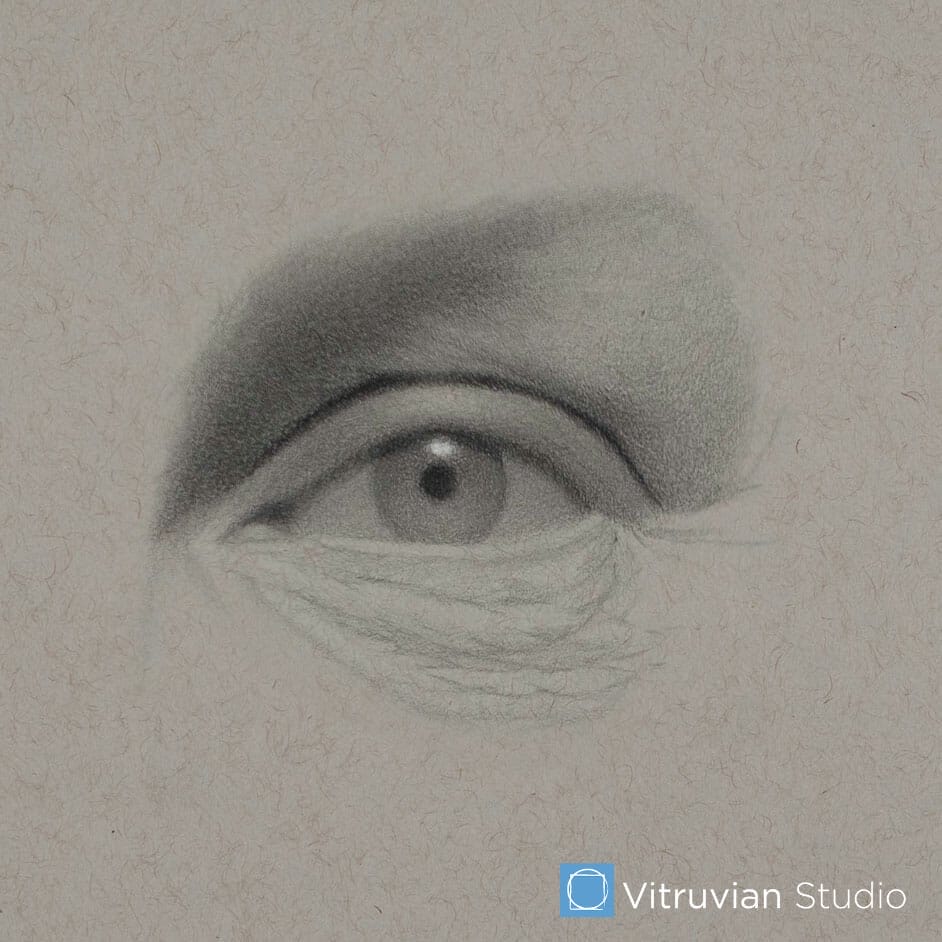

For those learning how to sketch an eye or working on an eye sketch drawing, as you develop your values, try to think about “sculpting” the form as you go. This is why we typically refer to this stage as “modeling” rather than “shading”. The goal here is to uses gradients and progressions of value to gently “turn” the surface of the form up toward the light (lighter) or down and away from it (darker). It can help to imagine while drawing that your pencil is a tiny clay tool, pushing and pulling the surface of a little virtual sculpture that sits behind the picture plane. Thinking this way can help you fine-tune your values, and free you from the tyranny of merely “copying” what you see – which usually doesn’t produce the best results.
7: Eyelashes, Highlights and Other Details
Once you’ve developed the major forms on your drawing, you’re nearly at the finish line. What remains is to observe some of the smaller details and describe those as well, integrating them into the broader value structure you’ve already established.
But first, I should say that you don’t actually have to do this. I got a bit ahead of myself and developed some of the wrinkles under the lower lid already, but you could opt to simplify your drawing by not getting quite so granular. Contrary to popular belief, more “details” isn’t always better in realism. Instead, it can result in a look that’s just too choppy and busy. On the other hand, details can be fun to draw, so do what feels right.
Eyelashes
Groupings
Learning how to draw eyelashes is an important final step in creating detailed eyes. Eyelashes sometimes cause problems for students in a way similar to drawing hair: we tend to think of them as individual hairs and fail to notice that hair usually congregates into groups.
Think of it this way: if you were a sculptor, you wouldn’t model the hair on a portrait bust by rolling out thousands of little spaghettis of clay and adding them one at a time. Instead, you would sculpt the overall shape of the hair mass. The effect of individual hairs would be a very minor detail, probably saved for the very end, if you included them at all.
We should try to handle hair of any kind in a similar way while drawing, including the eyelashes. Don’t draw individual lines for each lash. Instead, try to observe how the lashes group together. Sometimes, if your model is further away, they can be seen as a single ribbon-like form along the edge of the upper lid. In other cases, such as when your model is wearing mascara, the lashes tend to clump together, forming a number of spikey points, like curved daggers, jutting out from the eyelid.
Orientation
It’s also important to consider the orientation of the eyelashes as they protrude from the edge of each lid. Remember, the eyeball is curved, and the eyelids along with them. Eyelashes almost always project outward from the eye, roughly perpendicular to the surface of the eyeball. So, lashes that are set in the center of the eyelid will project roughly forward. But as the eyelid wraps around the eyeball, its surface changes orientation. Approaching the lateral corner of the eye, the lashes will appear to project somewhat sideways, but still perpendicular to the surface of the eyeball (or close).
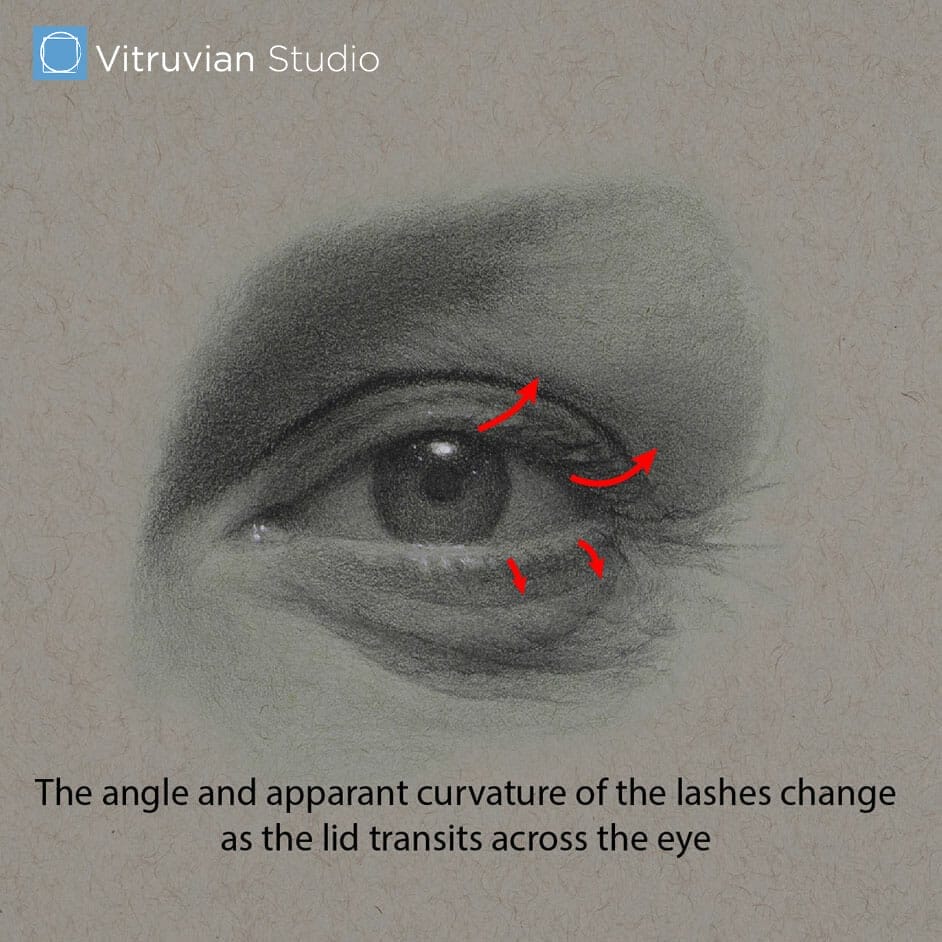
Curvature
Eyelashes are never straight, but curved. The trajectory of the upper lashes projects outward from the bottom edge of the eyelid, but then curves gently upward toward the tips. This effect is even more pronounced if your model is wearing mascara or fake eyelashes, in which case the curved sweep of the lashes will be unmistakeable.
Highlights
Learning how to draw highlights in eyes or how to draw eye highlights is essential for creating realistic, living eyes. Highlights are just tiny reflections of the light source bounced off the surface of a form. They’re not always clearly visible, but when they are, it’s usually on smooth, glossy surfaces… like an eyeball.
A highlight will be visible on the eyeball when the incident rays from the light source bounce off its surface at just the right angle toward the eye of the viewer. In this case, there is a pretty strong highlight just above the pupil. But there are other, smaller, dimmer highlights to be seen in on the slick surfaces of the inner canthus and along the top of the lower lid where it meets the wet surface of the eyeball.
Depending on how bright the highlights are, and the value of your paper, you may find it necessary to use some white chalk to get the right value. In this case, because the surrounding value of the iris is so dark, I began by erasing any graphite in the area first, then applied chalk opaquely with a sharp General’s Charcoal White pencil. The other, dimmer highlights were also applied with the chalk pencil, but less opaquely.
Other Details
At this point, you may be done drawing your eye. Including surface details like wrinkles and pores in the skin often isn’t necessary, and can even detract from your drawing if they’re mishandled.
If you do choose to pursue this level of description, be aware that many of the wrinkles or “crows feet” we see around the eye are set perpendicular to to the muscle fibers of the Orbicularis Oculi, which travel around the eye region in concentric circles. When these muscle fibers contract, they cause the the eye to scrunch up – like the draw string in a hoodie – causing wrinkles to radiate outward, cutting across their circular path.
The skin under the eye, between the lower lid and the infraorbital furrow, is quite soft and sensitive. It can show variations in color, such as redness or subtle violet tones. As we age, this area can also be a locus of small wrinkles as sagging skin collects above the rigid bottom edge of the eye socket.
If you choose to describe those wrinkles as I did, just remember that small features on the skin are forms, just like the larger ones, and every form has a light side and a dark side. Students often go astray when drawing wrinkles by focusing too much on the grooves in the skin, drawing them as lines on the page. But it’s important to remember that most texture we might try to describe – including on the skin – is just an arrangement of peaks and valleys.
Those grooves we see in wrinkles are depressions in the surface – little ruts and ravines that run between an arrangement of puckering fullnesses that project outward, each catching the light in its own way. These small but full forms between the wrinkles are what you want to focus on, describing the light side and dark side of each. Do that within an appropriate range of values, and the “wrinkles” will almost draw themselves.

Conclusion
For as much information as I’ve included in this post, it’s still not comprehensive. There’s a huge variety of human faces out there, and everyone’s eyes are a little bit different. Whether you’re drawing human eyes, working on eyes in perspective, learning how to draw eyes step by step, or practicing drawing eyes, add to that different perspectives and lighting conditions, and there is simply no single approach to drawing eyes that is correct or complete.
This comprehensive guide covers everything from basic eye drawing and simple eye drawing techniques to more advanced concepts like eye anatomy for artists and drawing eyes from the side. Whether you need an eye drawing guide or are looking for tips for drawing eyes, the best way to draw eyes is ultimately through practice.
Ultimately, how to get better at drawing eyes comes down to one thing: the best way to draw better eyes is to draw lots of them – practice is the key to honing any skill, including drawing. Keep working on your eye drawing practice, use quality eye reference materials, try different types of eyes, experiment with different eye shapes, and don’t be afraid to make mistakes. With consistent practice drawing eyes, you’ll develop your own approach to creating realistic human eye drawings.
So I hope you find the information presented here helpful as you work to develop your drawing skills. Now it’s time to pick up your pencil and start drawing!


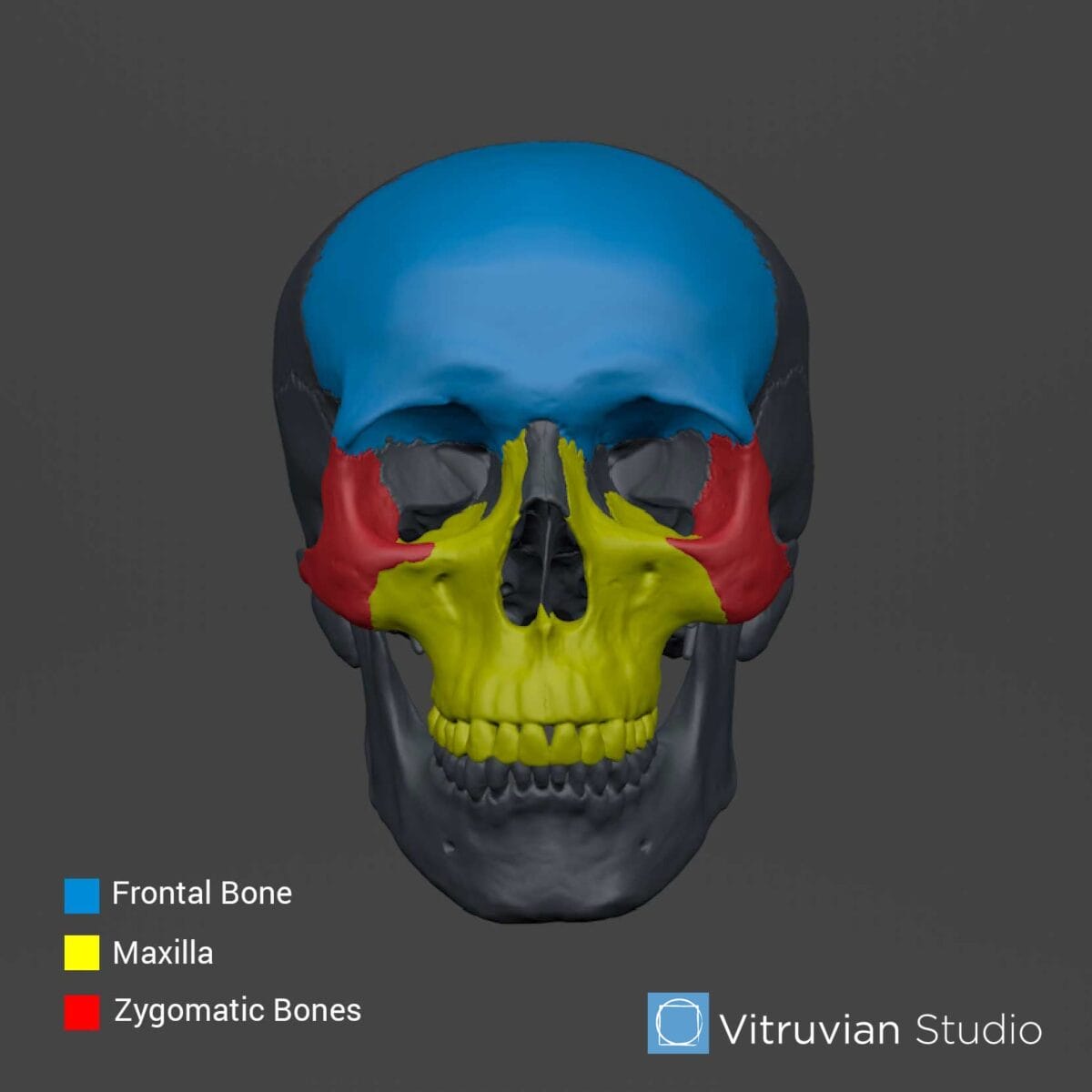
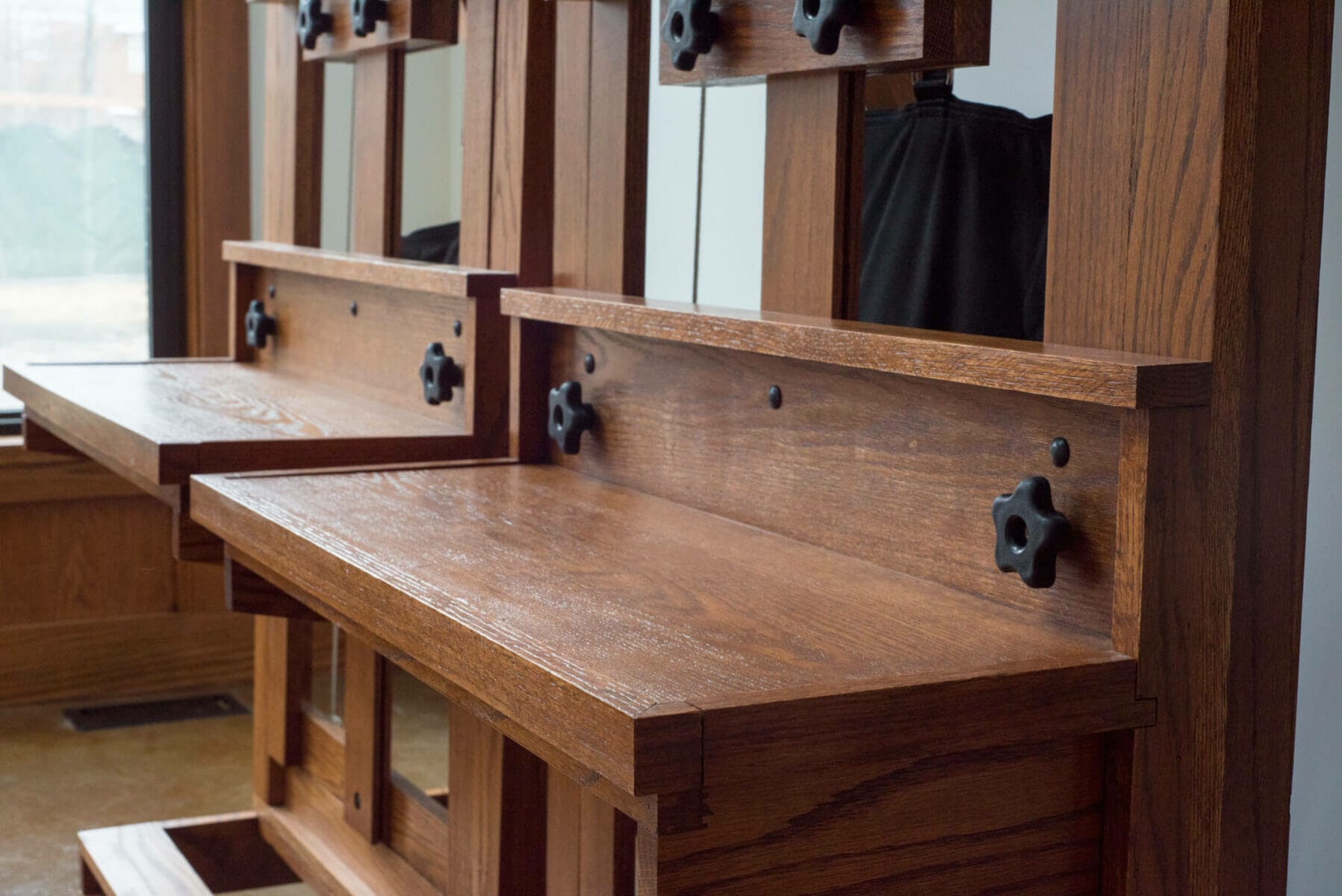
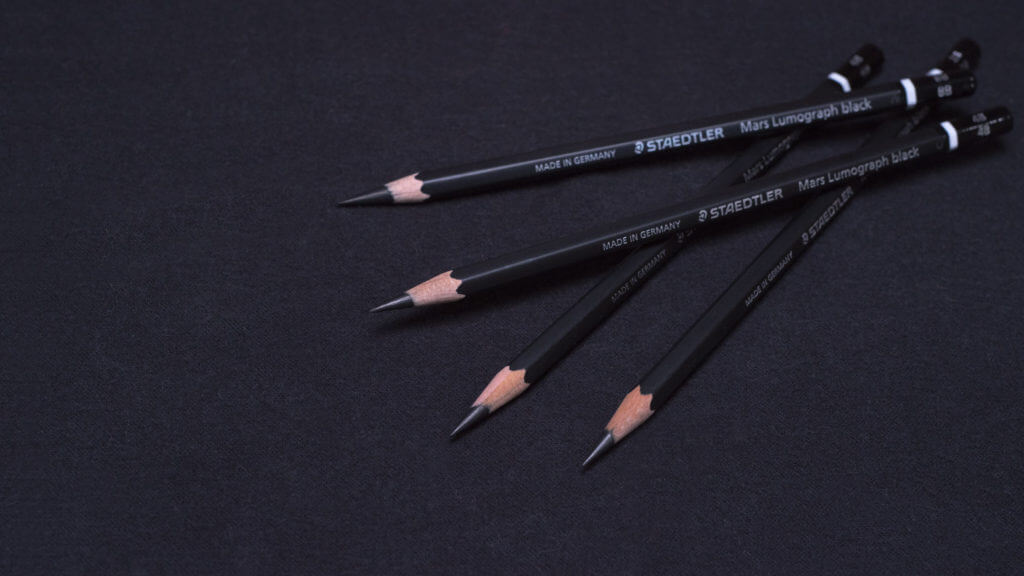

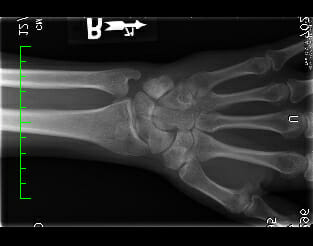

Works well, I am impressed
You are a great teacher and I am learning so much!
Absolutely brilliant description on the drawing process, you are teaching me so much with this concise information, that i never knew about. Thank you so much
I’m glad it’s helpful for you, Tim!
Bonsoir
Merci pour votre cours qui m’aide énormément dans ma progression du dessin.
Je suis avide de conseils afin de m’améliorer au niveau des portraits.
Merci pour ces précieux conseils.
Cordialement
I looked at your finished work and it’s amazing to me such creativity and beauty can come from a another person. I have not been drawing for over 35 years and now just getting back to it. It will be a dream come true to reach this level. Thanks for your help to get a little closer to my dream.
I’m glad it’s helpful, James! Best of luck!
As always, a wonderful explanation of what is happening, and a great illustration of it in your accompanying drawing. I echo what others have said. As one who has taken your portrait course, this post adds a lot to it. I get it about not focusing on “eyes, ears, mouth” separately but the detailed explanation is extremely helpful! Vitruvian Studio is the best! Thanks, David!
Thanks!
Great to hear, Lane. I’m glad it’s helpful!
So helpful! Presenting the bone structure and then adding each layer is a great way to grasp the subtleties of the complex eye area. Thanks very much.
Viva Vitruvian!
Thanks, Deedle!
Many thanks for the article – it compactly and comprehensively describes the sequence of work on drawing an eye. I wish you success!
I love the way you are teaching , I would like learn more, thank you.
nice job much too dark but great
I read 2 words of the joke and had to be rushed to hospital! 😀
Ha!
Wonderful!
Thank you. Thank you. I’m so glad you decided to go ahead and share your logic and in-depth instruction. I’ve said for years that you can’t isolate pieces parts of the face, or really any part of the body from another. You have explained the reasons for this perfectly. Hopefully enough people will find you, and steer clear of the glut of misinformation and shortcuts that are so prevalent. This is pure gold! Thank you–again!
That’s great to hear, Judy!
Thank you for this most useful additional content David – especially after purchasing classes. It makes a student feel “connected” to Vitruvian Studio ongoing and adds additional value to what i have learned already !
You’re very welcome, Jonathan. We’re happy to be connected with you, too! There’s always more to say about about drawing, so I’m glad this post adds some more value to your experience here!
Ditto. I can’t say it any better than Jonathan did. Thank you.
Thank you David; this is helpful in conjunction with the Portrait Class. I have to admit that this was new to me and have been struggling a bit (in a good way) with the eyes. Your discussion in the portrait class about really thinking in 3D, was very good and “eye” opening to me, since I really have been a cartoon sketcher in my younger years. Thanks.
I’m glad it’s helpful, Jay!